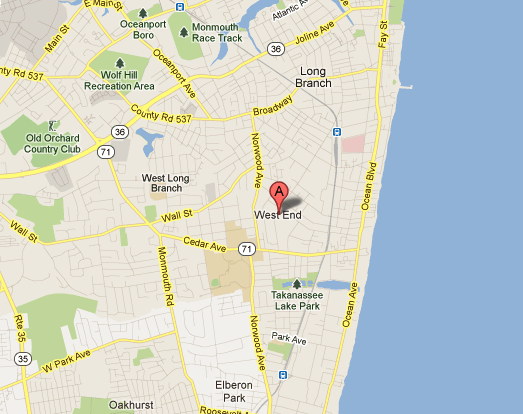Geography and Maps
State of Rhode Island
I'm encroaching on Paul's territory here, but I just learned a weird factoid about Rhode Island geography so I thought I'd share. And I'm sure many of you will also know this, but if it was new to me I'm hoping it may be new to a few of you as well.The factoid: Most of Rhode Island is not Rhode Island. It's the Providence Plantations.
Rhode Island's full name is "The State of Rhode Island and Providence Plantations," which makes it the longest state name in the U.S. But technically, Rhode Island is just a single island in Narragansett Bay. The island is also known as Aquidneck Island. The mainland part of the state is the Providence Plantations.
In 1975, State Sen. Ambrose Campbell introduced a bill to officially shorten the name to "The State of Rhode Island," but the bill didn't pass. So the full, long name remains.
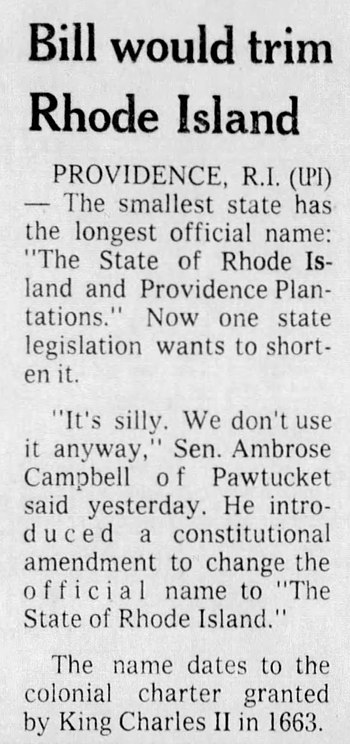
Minneapolis Star Tribune - Apr 10, 1975


Santa Cruz Sentinel - Jul 17, 1975
Posted By: Alex - Tue Oct 03, 2017 -
Comments (3)
Category: Geography and Maps, 1970s
Goblu and Beatosu, Ohio
The 1978-79 Michigan Highway map included some creative geography. If you looked at the part of the map that depicted neighboring Ohio, you found two new towns. There was Goblu, shown just east of Toledo near Bono, and Beatosu, shown to the west near Elmira. These names sounded a lot like the cries of University of Michigan football fans against rival Ohio State University.They were included in the map at the order of Peter Fletcher, the highway commission chairman, who said he included the names to demonstrate his "loyalty to the Athens of the West, the University of Michigan." The fictitious towns were deleted from the next edition of the map. The map with the towns is now a collector's item. One is currently available for $32.55 on eBay.
More info: wikipedia


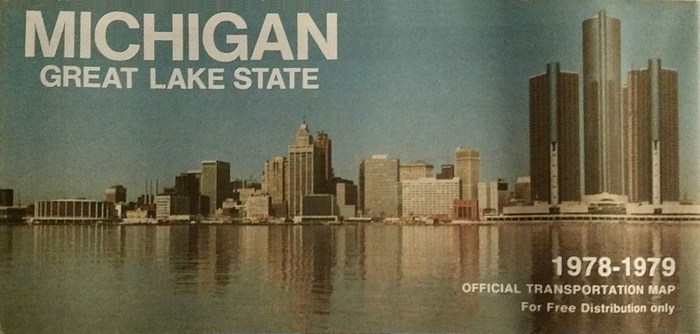
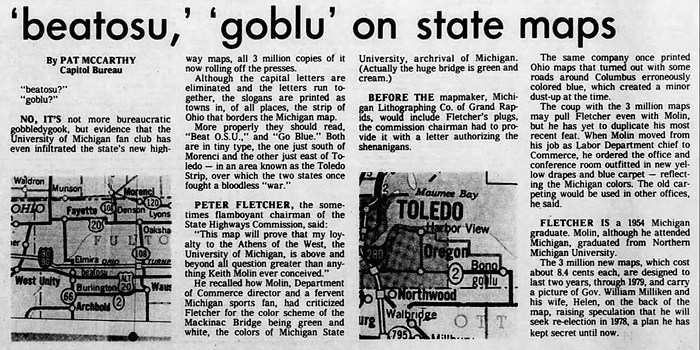
Lansing State Journal - Dec 23, 1977 (click to enlarge)
Posted By: Alex - Wed May 17, 2017 -
Comments (4)
Category: Geography and Maps, Hoaxes and Imposters and Imitators, 1970s
Theory of Continental Drip
Ormonde de Kay, Jr. first proposed the "theory of continental drip" in Horizon magazine (Winter 1973), although it was more of an observation than a theory. He wrote: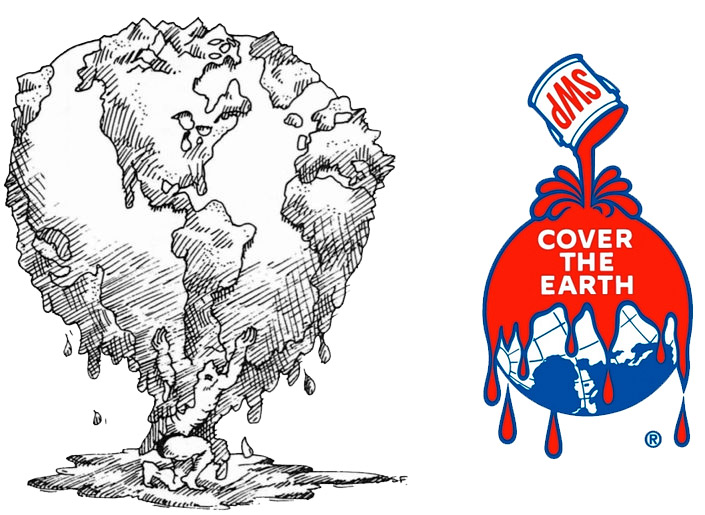
De Kay's article was meant to be tongue-in-cheek, and there have been several elaborations of his theory in the same vein, such as here and here.
However, it's true. Continents and peninsulas do seem to "drip" south — Africa, South America, Baja California, Florida, Greenland, Scandinavia, Italy, Greece, India, Malaysia, Indochina, and Korea.
So why? Is there a reason? De Kay wrote:
But like I said, De Kay wasn't being completely serious. The closest I've been able to find in the way of a genuine scientific response to this mystery is in New Scientist magazine (Dec 18, 1999), when a reader wrote in asking about the dripping continents and received the following response:
In other words, there really is no reason for the dripping. It's just random chance.
Posted By: Alex - Wed Nov 16, 2016 -
Comments (6)
Category: Geography and Maps, Science
The Yellowstone Zone of Death

Yellowstone National Park contains a 50-square mile "zone of death" where, legal scholars suggest, a person could commit murder without fear of prosecution. This zone is the part of the park that extends into Idaho.
The reason for this free-pass-for-murder lies with the Sixth Amendment which guarantees a defendant the right to a trial by a jury "of the state and district wherein the crime shall have been committed." The zone is in the State of Idaho, but because of the unique legal status of Yellowstone, it's in the judicial District of Wyoming. Therefore, to prosecute anyone a court would need to form a jury of people who live simultaneously in the State of Idaho and the District of Wyoming, and no one fits that bill because no one lives in the Idaho part of Yellowstone. Without being able to create a jury, a trial couldn't proceed.
A similar zone exists in the part of Yellowstone that extends into Montana. However, a few people live there, so a jury could, in theory, be formed from its residents.
This legal loophole was first pointed out in 2005 by Brian Kalt, a professor at Michigan State Law School, in an article published in the Georgetown Law Journal. Kalt urged Congress to pass legislation to fix the loophole before someone tested the loophole by committing murder in the death zone. The simplest fix, he proposed, would be to change the district lines so that the part of Yellowstone in Idaho would be included in the District of Idaho.
To date, Congress has not done anything to fix the problem. Part of the reason for this is political inertia. But there's also resistance to changing the District lines because this would place part of Yellowstone under the jurisdiction of the more liberal Ninth Circuit Court of Appeals which, it's feared, environmentalists could use to their advantage. So the "zone of death" remains.
The idea of a legal "zone of death" has naturally appealed to the imaginations of artists. The zone was featured in a best-selling mystery novel, Free Fire, by CJ Box. And in 2016 it became the subject of a film, Population Zero (trailer below).
More info: npr.org, bbc news, vox.com.
Posted By: Alex - Sun Jul 24, 2016 -
Comments (8)
Category: Crime, Geography and Maps, Law
South Dakota’s Western Border
If you look at a map of South Dakota, you can see that the western border isn't perfectly straight. Right where Wyoming, Montana, and South Dakota meet, the border jogs inward a little bit.The story goes (which I've found in several sources) that this isn't how it was supposed to be. The border was supposed to run straight down the 27th meridian, but the surveyors messed up. The lines they ran from north and south didn't meet up properly, and to fix the error they just made the border jog in slightly, as it does, in order to connect the two lines.
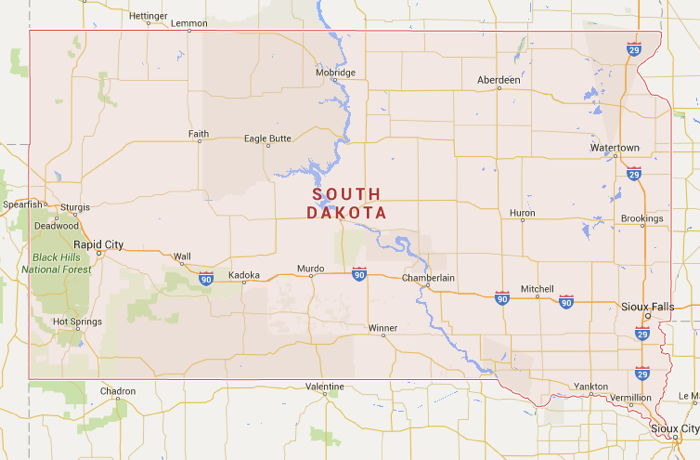
You can find the story of the surveying error told in Joey Green's Dumb History. There's also some discussion of the issue over at the Straight Dope message boards.
Posted By: Alex - Fri Jun 24, 2016 -
Comments (3)
Category: Geography and Maps
True Legend
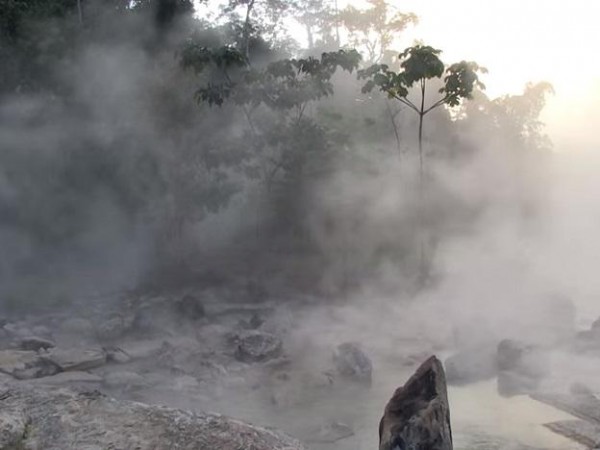
Andres Ruzo grew up with the story of the boiling river as told to him by his grandfather. Later, as a geoscientist, he decided to try and validate the legend. The Boiling River: Adventure and Discovery in the Amazon is the story of how, as a man, he proved the legend that captivated him as a boy.
Posted By: Alex - Wed Feb 17, 2016 -
Comments (5)
Category: Geography and Maps, Science, Books, Myths and Fairytales
Satanic Thomas Guide
The front cover of the 1997 Thomas Guide road atlas for Los Angeles and Orange Counties boasted that the guide that year included "666 new streets."This prompted concerned Christians to start calling the publisher of the guide, fearing that the use of the number 666 was some kind of satanic signal.
Eventually the publisher recalled the Guide and issued a new one, with a revised cover boasting only "665" new streets. A Thomas Guide spokesman said it wanted buyers to "feel confident with the use of our product."
I've found a few of the satanic Thomas Guides for sale on eBay. However, I've been unable to find any of the revised ones.
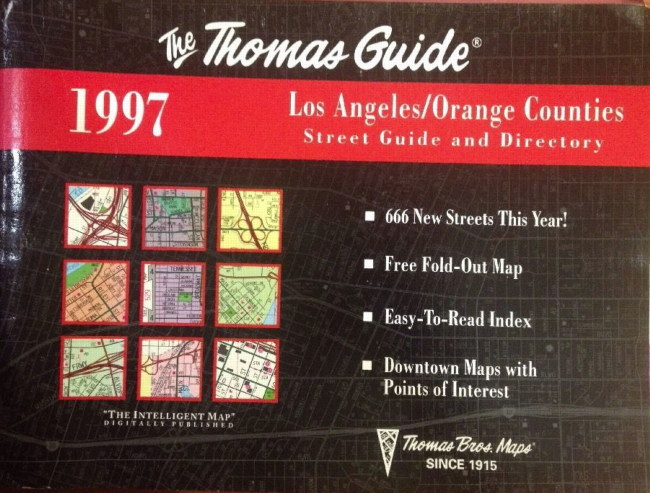
More info: La Times - Oct 28, 1999
Update: I spoke too soon. Using some slightly different search terms, I was able to track down one of the revised (non-satanic) Thomas Guides for sale on eBay.
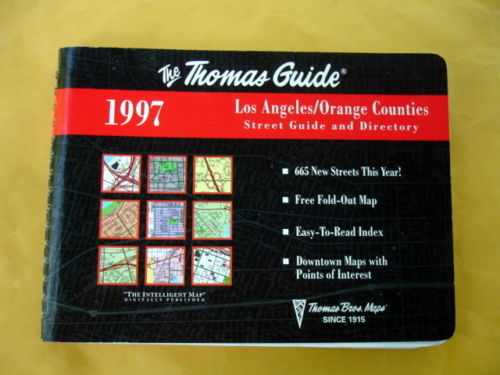
Of course, the revised cover was a bit of a hoax. There actually were 666 new streets, but they were telling people there were only 665. Unless they actually deleted one of the streets from the guide. An appropriate street to delete would have been Devilwood Circle, in Westminster, CA (Orange County).
Posted By: Alex - Thu Oct 29, 2015 -
Comments (18)
Category: Geography and Maps, 1990s
Sleepy Eye, MN
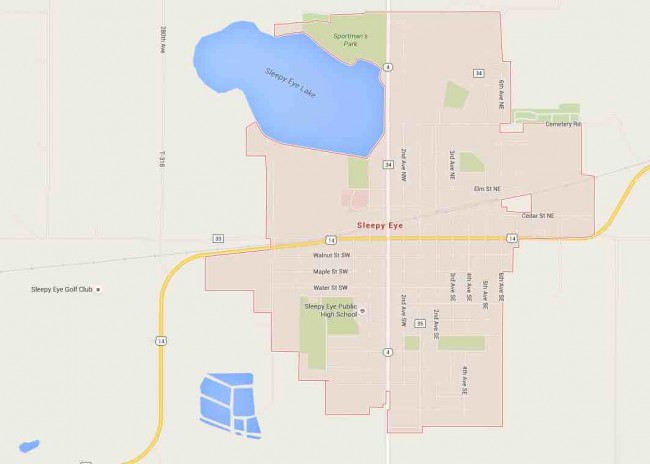

[Click to enlarge text]
Wikipedia page here.
Posted By: Paul - Thu Oct 29, 2015 -
Comments (3)
Category: Geography and Maps, Odd Names, Regionalism, North America, Native Americans
The Sunshine Belt
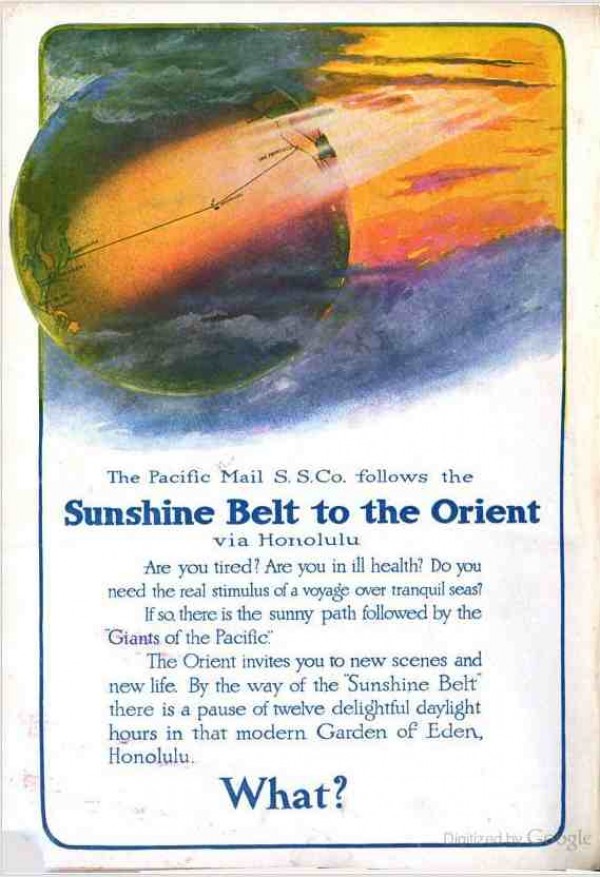
As Alex showed us earlier, Florida merited a celestial spotlight to be shone upon it. But it was not the only favored land!
Original ad here.
Posted By: Paul - Fri Jan 16, 2015 -
Comments (5)
Category: Geography and Maps, Advertising, 1910s, South Pacific
West End, New Jersey
West End, New Jersey has a minor claim to fame as the birthplace of Dorothy Parker. It used to be its own village, but now I think it's just a suburb of Long Branch. But what makes it unusual is its name. It's surrounded on three sides by Long Branch, and on the other side it faces the Atlantic Ocean. So what exactly is it on the west end of?
Posted By: Alex - Thu Feb 28, 2013 -
Comments (5)
Category: Geography and Maps, Weird Names

| Who We Are |
|---|
| Alex Boese Alex is the creator and curator of the Museum of Hoaxes. He's also the author of various weird, non-fiction, science-themed books such as Elephants on Acid and Psychedelic Apes. Paul Di Filippo Paul has been paid to put weird ideas into fictional form for over thirty years, in his career as a noted science fiction writer. He has recently begun blogging on many curious topics with three fellow writers at The Inferior 4+1. Contact Us |

